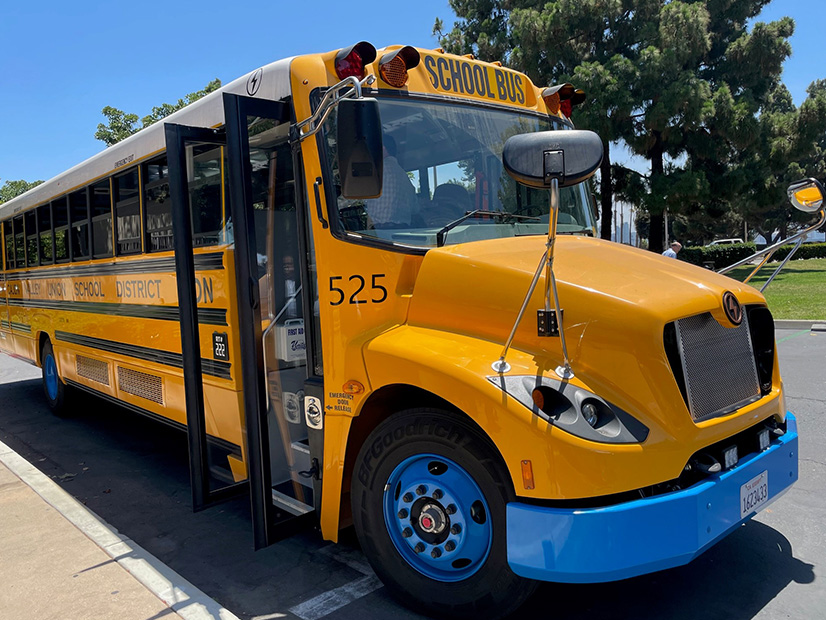
Small fleets of electric school buses near San Diego will be part of the first vehicle-to-grid (V2G) project to participate in a program intended to boost reliability during electric emergencies, such as the rolling blackouts that hit California in August 2020.
The Lion Electric buses in the Cajon Valley Union School District will be aggregated with others in the nearby Ramona Unified School District to form a participating resource under the Emergency Load Reduction Program (ELRP), started last year by the California Public Utilities Commission.
The state’s three large investor-owned utilities — Pacific Gas and Electric (NYSE:PCG), Southern California Edison (NYSE:EIX) and San Diego Gas & Electric (NYSE:SRE) — manage the five-year ELRP pilot, which CAISO can call on as a last resort when shortfalls are imminent, as they were during electric emergencies the past two summers.
In the Cajon Valley school bus yard, SDG&E installed six 60-kW, bidirectional DC fast chargers able to participate in the ELRP, which pays business customers $2/kWh to export energy or reduce demand in grid emergencies. The first set of bidirectional chargers went live on SDG&E’s grid last month.
A V2G project participating in the ELRP is a first, said Jacqueline Piero, vice president of policy for Nuvve (NASDAQ:NVVE), a V2G technology developer that is partnering with the school districts and SDG&E in the effort.
“It’s a great demonstration of how electric vehicles don’t need to just be providing emergency backup,” Piero said. “They can actually be substantively contributing to the reliability of the grid in an aggregated manner.”
Nuvve previously worked with the Torrance Unified School District near Los Angeles on a demonstration V2G bus project, but it was connected to school district buildings and not to SCE’s grid. A similar project at the University of California, San Diego, supplied electricity to the university’s microgrid but did not connect to SDG&E’s system.
Bidirectional EV charging, allowing vehicle fleets to connect to the grid, was not permitted prior to September 2020, when the CPUC changed its interconnection rules, letting fully integrated V2G projects move forward.
“We’re really just now being able to take advantage of the updates in the interconnection rules,” Piero said. “So even though we did a project in Torrance where we were doing real work with their demand charges, we were not interconnected, and we were not allowed to export.”
The company was part of a V2G project in Denmark that showed connected vehicles could provide frequency response and other grid support services. It was one of dozens of V2G demonstration and pilot projects started in Europe, the U.S. and Asia over the past 10 years.
California is home to more than 1 million EVs and is under a mandate to sell only emissions-free passenger vehicles, primarily EVs, starting in 2035.
Earlier this year the CPUC signed onto the U.S. Department of Energy’s Vehicle to Everything (V2X) agreement, a “collaboration for accelerating development and commercialization of vehicle-to-everything technologies, which include vehicle-to-grid, vehicle-to-building and vehicle-to-load capabilities, by validating the technologies and demonstrating the commercial viability of such technologies.”
The effort is intended to bring together cutting-edge resources from the department’s National Laboratories, state and local governments and utilities to “evaluate technical and economic feasibility as we integrate bidirectional charging into energy infrastructure,” DOE said in a news release.
SDG&E was a signatory to the V2X agreement, along with PG&E, SCE and the California Energy Commission.
“Electric fleets represent a vast untapped energy storage resource and hold immense potential to benefit our customers and community, not just environmentally but also financially and economically,” SDG&E Vice President of Energy Innovation Miguel Romero said in a joint news release with the Cajon Valley school district and Nuvve.
PG&E and Ford said in March they would test the V2G potential of the automaker’s F-150 Lightning electric pickup trucks. Bus and commercial truck fleets with predictable schedules and more capacity are optimal V2G candidates.
“School buses are an excellent use case for V2G,” Nuvve CEO Gregory Poilasne said in the news release. “They hold larger batteries than standard vehicles and can spend peak solar hours parked and plugged into bidirectional chargers. Nuvve’s technology enables the grid to draw energy from a bus when it is needed most, yet still ensuring the bus has enough stored power to operate when needed.”
